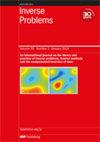Solution of the EEG inverse problem by random dipole sampling
IF 2
2区 数学
Q1 MATHEMATICS, APPLIED
引用次数: 0
Abstract
Electroencephalography (EEG) source imaging aims to reconstruct brain activity maps from the neuroelectric potential difference measured on the skull. To obtain the brain activity map, we need to solve an ill-posed and ill-conditioned inverse problem that requires regularization techniques to make the solution viable. When dealing with real-time applications, dimensionality reduction techniques can be used to reduce the computational load required to evaluate the numerical solution of the EEG inverse problem. To this end, in this paper we use the random dipole sampling method, in which a Monte Carlo technique is used to reduce the number of neural sources. This is equivalent to reducing the number of the unknowns in the inverse problem and can be seen as a first regularization step. Then, we solve the reduced EEG inverse problem with two popular inversion methods, the weighted Minimum Norm Estimate (wMNE) and the standardized LOw Resolution brain Electromagnetic TomogrAphy (sLORETA). The main result of this paper is the error estimates of the reconstructed activity map obtained with the randomized version of wMNE and sLORETA. Numerical experiments on synthetic EEG data demonstrate the effectiveness of the random dipole sampling method.通过随机偶极取样解决脑电图逆问题
脑电图(EEG)源成像旨在根据头骨上测量到的神经电位差重建大脑活动图。要获得脑活动图,我们需要求解一个条件不良的逆问题,该问题需要正则化技术才能求解。在处理实时应用时,可以使用降维技术来减少评估脑电图逆问题数值解法所需的计算负荷。为此,我们在本文中使用了随机偶极采样法,其中使用了蒙特卡罗技术来减少神经源的数量。这相当于减少了逆问题中未知数的数量,可视为第一个正则化步骤。然后,我们用两种流行的反演方法--加权最小规范估计法(wMNE)和标准化低分辨率脑电磁断层扫描法(sLORETA)--解决了减少后的脑电图反演问题。本文的主要成果是利用随机版 wMNE 和 sLORETA 获得的重建活动图的误差估计。在合成脑电图数据上进行的数值实验证明了随机偶极子采样方法的有效性。
本文章由计算机程序翻译,如有差异,请以英文原文为准。
求助全文
约1分钟内获得全文
求助全文
来源期刊

Inverse Problems
数学-物理:数学物理
CiteScore
4.40
自引率
14.30%
发文量
115
审稿时长
2.3 months
期刊介绍:
An interdisciplinary journal combining mathematical and experimental papers on inverse problems with theoretical, numerical and practical approaches to their solution.
As well as applied mathematicians, physical scientists and engineers, the readership includes those working in geophysics, radar, optics, biology, acoustics, communication theory, signal processing and imaging, among others.
The emphasis is on publishing original contributions to methods of solving mathematical, physical and applied problems. To be publishable in this journal, papers must meet the highest standards of scientific quality, contain significant and original new science and should present substantial advancement in the field. Due to the broad scope of the journal, we require that authors provide sufficient introductory material to appeal to the wide readership and that articles which are not explicitly applied include a discussion of possible applications.
 求助内容:
求助内容: 应助结果提醒方式:
应助结果提醒方式:


